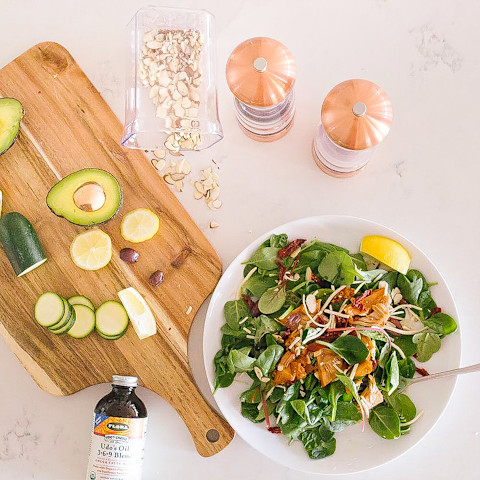Know Your Good Fats: How To Balance Omega-3s, 6s & 9s

In the nutrition world, fats are a bonafide Healthy-or-not-Healthy Hall of Famer. At this point, research has settled on the overarching message that eating "good" unsaturated fats in place of saturated fat can lower the "bad" LDL cholesterol, helping prevent heart disease1.
A major player in getting us here? Omega-3 fatty acids, a type of polyunsaturated fat. They're a huge reason Japanese and Mediterranean diets, which regularly include helpings of omega-3-rich seafood, have been associated with lower instances of heart disease. But they're not the only fatty acids to know. Read on to learn the major differences between omegas-3, 6, and 9 and why it's important to balance them in our diets.
Omega-3
The basics: A type of polyunsaturated fat that's considered an essential fatty acid (meaning our bodies can't make it, so we need to get it from food sources). It's found in fish, nuts, and plant-based oils.
The benefits: Eating foods rich in omega-3 fatty acids has been shown to help lower the risk of chronic diseases such as heart disease, lower blood pressure2, reduce inflammation3 (which can even have mental health benefits4), and strengthen bone density5.
Omega-6
The basics: Another type of polyunsaturated fat that's also essential. We get it from foods like meat, poultry, and eggs, as well as nuts, seeds, and plant-based oils.
The benefits: Omega-6s may play a role in brain function, skin and hair growth, bone health, and metabolism and may also help keep blood sugar in check.
Omega-9
The basics: A type of monounsaturated fat that is found in vegetable and animal fats. Unlike omega-3s and omega-6s, omega-9 fatty acids are produced by the body but are also beneficial when obtained through our food.
The benefits: Omega-9s may help control blood sugar balance6 and protect against heart disease.
How omega-3s, 6s, and 9s add up in our bodies
All three of these fatty acids play a role in helping our bodies function their best, with one caveat: There's an optimal omega ratio for good health. Unfortunately, the modern American diet has shifted many of us way off balance.
Over the last century, Western populations have started eating a lot of seed and vegetable oils—to the point that these oils comprise over 20% of our calories by some estimates. And many—like soybean oil, which is found in all sorts of processed foods because it's so cheap—are loaded with omega-6s. According to recent research, the amount of omega-6s in our body fat stores has increased by more than 136%7 in the past 50 years alone—and it's leading to some not-so-great health changes.
Science is uncovering that high amounts of omega-6s are strongly associated with the risk of heart disease8 and increased inflammation9. On the flip side, lower amounts of omega-6s combined with higher amounts of omega-3s help suppress these risks9.

How to balance your omegas.
Experts agree that the optimal omega-6-to-3 ratio10 should be between 2:1 and 4:1. So ideally, you want to reduce your omega-6 intake down from the typical 16:1 ratio11 found in many Western diets that are lacking in omega-3.
How does one get the right balance? Remember, all foods with fat in them contain a mix of different fats; a common misconception is that when you eat a certain food, you're only getting one type of fat. (This goes for saturated and unsaturated fat as well as the fatty acids). For instance, tuna canned in water has a 1:31 ratio of omega-6 to omega-3; dry-roasted almonds have a ratio of 2,010:1—so almond lovers, make sure you're upping your omega-3 intake!
If you're not sure how to balance your omega intake based on your diet, talk with your doctor or an R.D. who can help. Omega-3, 6, and 9 supplements are another way to make sure you're getting the fats your body needs. Udo's Oil 3 6 9 Blend keeps it simple: One tablespoon a day has twice as much omega-3 as omega-6, helping you to rebalance toward a more optimal ratio in a non-GMO, organic, and keto-friendly formula.
The deal with plant-based omega-3s.
The fatty acids in Udo's Oil are sustainably derived from plant sources like organic flax, not fish, making it a great supplement option for vegetarians and vegans. For the record, plant-based omega-3s have been proved to be just as effective as seafood-based omega-3s in supporting heart health.*
For best results when supplementing with a flaxseed formula like Udo's Oil, be sure to include other food sources of omega-3 in your diet. Your body needs plenty of plant-based omega-3 (alpha-linolenic acid, or ALA) to convert to the longer-chain derivatives EPA and DHA, responsible for the benefits omega-3 fats provide (those longer chains are derived from seafood).
Bottom line: Knowing which food sources are high in the different kinds of fat can help you better choose heart-healthy options and balance your omegas for wellness.
The information in this article is the opinion of the author and/or individuals quoted and in no way reflects the policies or positions of Flora Health. This is not intended to be a substitute for professional medical or nutrition advice.
This statement has not been evaluated by the FDA. This product is not intended to diagnose, treat, cure, or prevent any disease.
11 Sources
- https://www.ncbi.nlm.nih.gov/pubmed/25161045
- https://www.ncbi.nlm.nih.gov/pubmed/26817716
- https://www.ncbi.nlm.nih.gov/pubmed/16841861
- https://www.ncbi.nlm.nih.gov/pubmed/18640689
- https://www.ncbi.nlm.nih.gov/pmc/articles/PMC3884553/
- https://www.ncbi.nlm.nih.gov/pubmed/9497173
- https://www.ncbi.nlm.nih.gov/pmc/articles/PMC4642429/
- https://www.ncbi.nlm.nih.gov/pubmed/16387724
- https://www.ncbi.nlm.nih.gov/pubmed/19022225
- https://www.ncbi.nlm.nih.gov/pubmed/12442909
- https://www.sciencedirect.com/science/article/abs/pii/S0753332206002435
